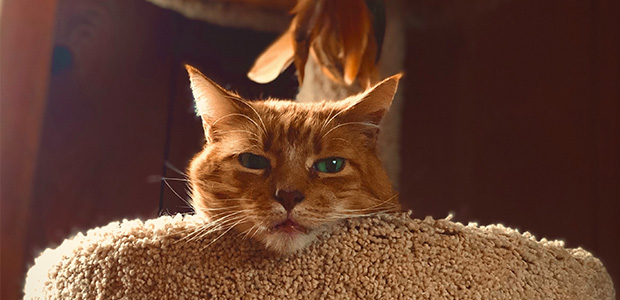Cats and fleas: does my cat have fleas?
A flea infestation can be a true nightmare but luckily, fleas are easy enough to prevent.
There’s a wide range of options available to help you avoid fleas, and to tackle them if you do suffer an infestation.
Let's take a closer look at cat fleas: how to spot them, why it's important to keep your cat protected and how to do so.
What are fleas?
Fleas are the most common cause of skin irritation in cats and kittens. They’re parasites that nestle into your cat’s fur, bite into their skin and feed on their blood.
How to tell if your cat has fleas
Your cat may have fleas and you may never see a single flea. You will be able to spot them, however, by watching out for these signs:
- Scratching
- Chewing at their fur
- Hair loss
- Restless behaviour
- Biting
- Licking
- Sores on the skin
- Fleas or flea dirt on the fur or skin
- Excessive grooming
Other problems caused by fleas
When a flea bites your cat and its saliva enters the bite wound, your cat may suffer an allergic reaction. Some cats develop sores on their skin, which often become infected.
Some cats are hypersensitive to flea saliva, and become intensely itchy. Kittens, elderly or sick cats can become weak and anaemic as a result of blood loss.
Fleas can also spread nasty diseases and are a common cause of tapeworms.
Will a flea infestation affect my home?
Fleas are drawn to hot, damp environments. During the winter, when the central heating’s on and everything is nice and cosy, fleas will be drawn indoors.
Fleas can jump up to 100 times their body length, and often hop from one cat to another. If one cat in your home gets fleas, you can bet the other will too.
Female fleas lay up to 50 eggs a day, so infestations are quick to take hold. If one cat in your home gets fleas, you can bet the other will too.
They won't just affect your pet either, you'll need to treat your entire house to successfully remove an infestation.
How to keep my cat protected?
Luckily, preventing your cat from getting fleas couldn’t be easier! Using a routine parasite prevention treatment, administered on a regular basis, will make sure your cat stays flea-free. Treatments include spot-on solutions and tablets.
Have a chat with your vet to find out which preventative flea treatment is best suited to your cat.
To find out whether your cat has a flea problem, try checking their fur now and again - you can do this while they’re asleep on your lap!
It's too late. My cat has fleas! What should I do?
First off, don’t panic! Getting rid of fleas on cats may take a little while, but it’s certainly achievable - especially if you start as soon as you find a flea on your pet’s fur.
Successful flea control consists of two aspects, treating your cat and treating your home.
Treating your cat
If your cat is overdue for their preventative treatment, apply it immediately. If you’ve ran out, contact your vet right away. Meanwhile, flea combs can help to brush out the existing fleas that have taken residence on your cat’s fur.
If your cat will let you, a nice bath will also help to remove fleas from their coat.
Treating your home
It’s estimated that during an infestation, around 5% of the fleas will be on your actual cat while the remaining 95% will be lurking around your house!
To remove the fleas as quickly as possible, use a household flea spray recommended by your vet. Spray all surfaces in your home, paying extra attention to your cat’s favourite areas and anywhere snug and safe that may appeal to fleas - i.e. under the sofa. Treat your WHOLE HOUSE, even areas where your cat doesn’t spend any time. (We humans can spread flea eggs around the house on our shoes.)
Wash all of your cat’s bedding every few days for 1-2 weeks. To keep your floors as clean as possible, use the vacuum cleaner daily for 7-10 days.

What do fleas look like to the human eye?
Adult fleas are miniscule creatures - no bigger than a fleck of pepper. They’re dark and glossy in appearance, and may be there one moment and gone the next!
Can humans get fleas from cats?
Humans can’t ‘host’ fleas like cats can, but once an unprotected cat has brought fleas into the home and an infestation has begun, fleas can certainly bite humans!
Flea bites appear as small red dots, usually around the ankles. They’ll be mercilessly itchy too. Humans can be at risk of Bartonellosi (also known as cat scratch disease) if they’re repeatedly bitten by fleas, so make no mistake - protecting your cat against fleas is good for your health as well as theirs.
How do indoor cats get fleas?
Even indoor cats can get fleas. They might not go outside often but they could catch fleas from interacting with other animals - such as your friends’ pets, or even mice.
What does flea larvae look like?
Flea larvae look like tiny little worms. They’re white, with pale hairs. An individual larva will be no bigger than 2-5mm, so you may never see it!
Need more info?
For advice on flea prevention and treatment for cats, have a chat with your local vet.
Locate your nearest vet using our Find a Vet page, or speak to a vet online today.

